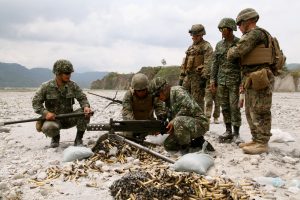Earlier this month, the administration of newly-inaugurated Philippine President Ferdinand Marcos Jr. announced the termination of a major helicopter deal with Russia that was signed under the administration of his predecessor Rodrigo Duterte, citing potential U.S. sanctions linked to Moscow’s invasion of Ukraine. While the development was part of an ongoing process, it nonetheless spotlighted the broader question of how Marcos may manage the U.S.-Philippine alliance within the country’s wider security approach and amid evolving bilateral, regional, and global realities.
As I’ve observed previously, Philippine defense policy has had to manage several internal and external challenges over the past few decades, including insurgencies, natural disasters, and unresolved territorial and sovereignty issues with neighboring states – and all this in a climate of anemic and at times astrategic investment.
Those realities have also factored into the U.S.-Philippine alliance that is enshrined in the 1951 U.S.-Philippine Mutual Defense Treaty. The alliance has seen its share of ups and downs over the decades, from the closure of U.S. bases by a razor-thin vote in the Philippine legislature in 1991 to the uptick of friction under Rodrigo Duterte, who had initially reversed Philippine positions on security issues such as the South China Sea, strengthened ties with China and Russia, and threatened to nix areas of cooperation including the Visiting Forces Agreement (VFA).
Seen from this perspective, Marcos’ election is yet another key inflection point in the evolution of Philippine defense policy. While the alliance had largely gotten back on track by the end of Duterte’s tenure, with the resumption of mechanisms for cooperation and even expansion in areas like exercises, the Marcos administration’s early words and actions such as the termination of the Russia helicopter deal have been closely scrutinized since he has not been entirely clear about his exact foreign policy positions to date.
Thus far, Marcos has sent some positive signals about expanding alliance cooperation, though his administration has also left the door open to advancing security collaboration with China, including in the maritime domain. There are also upcoming engagements that could reveal more about his foreign policy vision, including his expected first visits abroad to Indonesia and Singapore and an anticipated visit to the United States during this year’s United Nations General Assembly meetings.
While the focus may be on these headline developments early on, the trajectory of the alliance will also be contingent upon structural factors embedded in the broader evolution of the Philippines’ defense policy. Top of mind will be how the Marcos administration prioritizes the country’s mix of internal and external challenges, given that some of them, such as natural disasters and terrorism, may unexpectedly flare up as they have under previous administrations.
Another is the extent of continuity and change on the question of Philippine military modernization, including levels of spending and equipment prioritized under the Revised Armed Forces of the Philippines Modernization Program. Still another will be the mix of alignments that Manila invests in beyond the United States, be it with U.S. allies like Australia, Japan, and South Korea, which have expanded their security assistance to the Philippine military, or competitors like China that are consciously trying to make inroads with traditional U.S. allies.
To be sure, it is still early days in the Marcos administration, and the trajectory of Philippine security policy and the U.S.-Philippine alliance will likely become clearer in the coming months. With respect to Philippine security policy, we will likely learn more as signposts take shape, including appointments of defense and military personnel and Marcos’ first finalized budget following the proposal the administration has forwarded to Congress.
On the alliance side, which is also contingent on what Washington does, upcoming high-level visits and the convening of engagements like the expected “2+2” ministerial will reveal specifics regarding how defense ties fit into the wider U.S.-Philippine relationship, especially given broader realities including lingering human rights challenges voiced by some U.S. stakeholders. Both sides will also need to manage unexpected developments that could intervene, which includes not just potential regional flashpoints like the South China Sea but the fallout from geopolitical events like the U.S. withdrawal from Afghanistan, which has intensified terror fears in Southeast Asia.
These knowns and unknowns will gradually take shape in the coming months. And they will provide no shortage of issues to monitor closely with respect to how the Marcos administration looks to shape the U.S.-Philippine alliance as part of a broader security agenda that takes into account the changing domestic, bilateral, regional, and global realities.

































